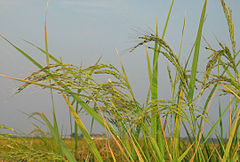Oryza sativa
taxon
(Redirectum de Oriza)
Oryza sativa, vulgo oryza, est planta herbacea quae duas familiae Poacearum subspecies annuas comprehendit, in tropicis et subtropicis Asiae et Africae regionibus australibus endemicas.

Et in Shinto Iaponiae, oryza origo cari cibi putatur et pro deitetibus dedicatur cum ritu festi.[1]
Notae
recensere- ↑ Exempli gratia, Kannamesai (Iaponice 神嘗祭) ad Ise Magnum Templum, quod die 17 Octobris celebratur.
Bibliographia
recensere- Robin G. Allaby, Chris Stevens, Leilani Lucas, Osamu Maeda, Dorian Q. Fuller, "Geographic mosaics and changing rates of cereal domestication" in Philosophical Transactions of the Royal Society B vol. 372 no. 1735 (2017)
- Cristina Cobo Castillo, "Rice in Thailand: The Archaeobotanical Contribution" in Rice vol. 4 (2011) pp. 114-120
- Dorian Q. Fuller, "Contrasting Patterns in Crop Domestication and Domestication Rates: Recent Archaeobotanical Insights from the Old World" in Annals of Botany vol. 100 (2006) pp. 903–924
- Dorian Q. Fuller, Cristina Cobo Castillo, "Origins and development of rice" in C. Smith, ed., Encyclopedia of Global Archaeology (Springer, 2013) pp. 6339-6343
- Jae Young Choi et al., "Nanopore sequencing-based genome assembly and evolutionary genomics of circum-basmati rice" in Genome Biology vol. 21 no. 21 (2020)
- J. P. Londo et al., "Phylogeography of Asian wild rice, Oryza rufipogon, reveals multiple independent domestications of cultivated rice, Oryza sativa" in Proceedings of the National Academy of Sciences vol. 103 (2007) pp. 9578–9583
- Xiaoyan Yang et al., "Barnyard grasses were processed with rice around 10000 years ago" in Nature Scientific Reports vol. 5 (2015) no. 16251
- Juzhong Zhang, Xiangkun Wang, "Notes on the recent discovery of ancient cultivated rice at Jiahu, Henan Province: a new theory concerning the origin of Oryza japonica in China" in Antiquity vol. 72 no. 278 (1998) pp. 897–901
